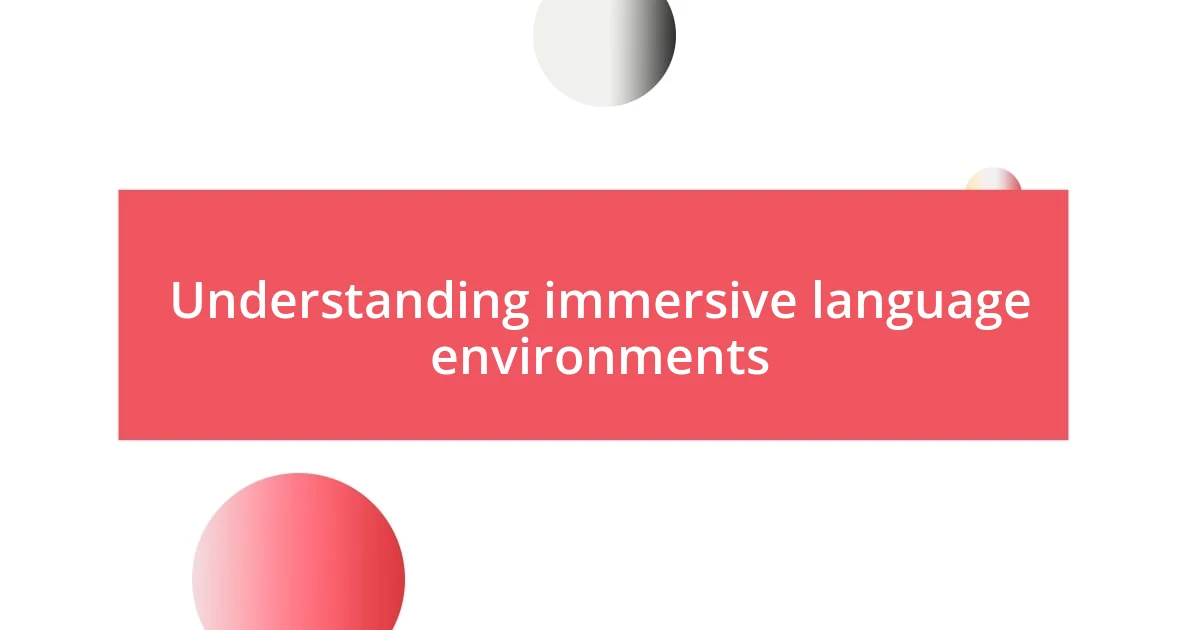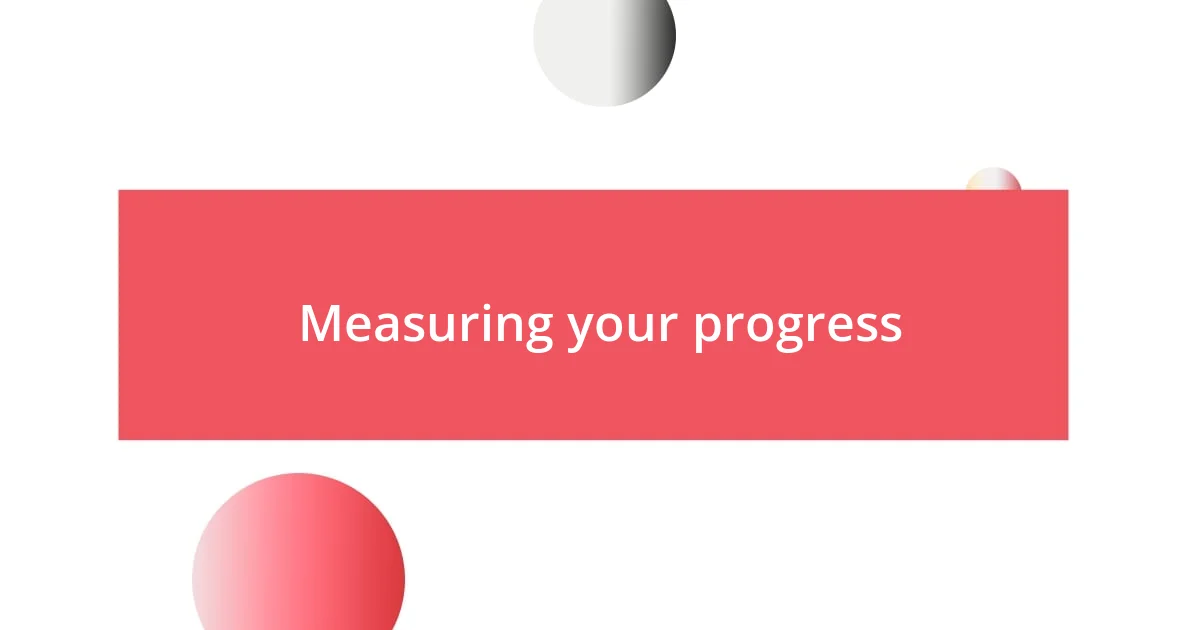Key takeaways:
- Immersion in a new language fosters real-life interactions and cultural understanding, enhancing fluency and confidence in learners.
- Creating a language-rich environment through labels, media engagement, and community connections maximizes the immersive experience.
- Tracking progress with a language log and self-assessment helps learners recognize milestones and areas for improvement, boosting motivation.

Understanding immersive language environments
Immersive language environments allow learners to engage deeply with a new language by integrating it into their daily lives. I remember when I first attended a language immersion program; I was nervous yet excited, as I knew I’d be surrounded by native speakers. Looking back, the intensity of those interactions pushed me out of my comfort zone in the best way possible.
What strikes me the most about these environments is how they mimic real-life scenarios, encouraging spontaneous conversations. There was a moment when I had to buy a train ticket in a foreign language, and my heart raced as I realized I had to think on my feet. Isn’t it fascinating how these experiences challenge us, often leading to breakthroughs in language learning?
Additionally, being immersed in a language doesn’t just enhance vocabulary; it also fosters cultural understanding. During my immersion experience, I learned idioms that were so tied to cultural context, it made me appreciate the language on a whole new level. Can you imagine how much richer our conversations could be if we fully understood the nuances behind the words?

Benefits of immersive language learning
Immersive language learning opens up a treasure trove of benefits that stretch far beyond simply acquiring new vocabulary. I still vividly recall my first conversation with a local shopkeeper during my immersion trip. The realization that I could navigate a spontaneous chat filled me with exhilaration—like unlocking a new level in a game. This kind of real-time interaction not only boosts fluency but also enhances confidence, making learners feel more competent in their language skills.
Here are some benefits I’ve personally experienced and observed in others:
- Enhanced Fluency: Constant exposure to the language accelerates the ability to think and speak more naturally.
- Cultural Insight: Immersion gives learners firsthand experience of the culture, leading to a deeper understanding of social norms, humor, and expressions.
- Confidence Building: Engaging in everyday conversations fosters self-assurance, reducing the fear of making mistakes.
- Increased Motivation: Being surrounded by the language and its speakers often fuels a love for learning and curiosity.
- Practical Application: Immersive settings create opportunities to use the language in real-life situations, making learning relevant and applicable.
Every moment spent learning in this way feels like a step toward fluency, each experience layering confidence and knowledge that standard classroom environments often struggle to replicate.

Setting up your immersive experience
Setting up your immersive experience is crucial for maximizing your language learning journey. Think about creating a space that envelops you in the target language. For instance, I found that labeling common household items with their names in the new language transformed my environment into a rich learning hub; every glance at a labeled item served as a gentle reminder to engage with the language daily.
Moreover, consider immersing yourself in media. I started watching films and listening to music in the language I was learning. The emotions conveyed in songs and the stories told in movies helped me connect with the language beyond just words. It’s like opening a window into the culture, allowing you to see the world through a different lens.
Lastly, I can’t emphasize enough the importance of community. Joining local language clubs or online groups fosters connections with other learners and native speakers. When I participated in a language exchange, it felt more like sharing a passion with friends than traditional learning. That social motivation propelled my learning and made every conversation more meaningful and memorable.
| Method | Description |
|---|---|
| Labeling Items | Transform common spaces into language-rich environments |
| Engaging with Media | Use films and music to deepen cultural understanding |
| Connecting with Others | Join groups for social interaction and real-life practice |

Finding language partners and resources
Finding language partners and resources is a pivotal step in developing your skills naturally. I remember the thrill of discovering a language exchange app; it connected me with a native speaker in another country. Every chat felt like a journey—it was as if I was walking alongside a friend, exploring not just vocabulary but also cultural nuances. Have you ever experienced that rush of excitement when you share a laugh over a mispronounced word? It’s these moments that truly enhance the learning process.
Another resource that has proven invaluable is social media. I often scroll through language-learning communities on platforms like Facebook or Instagram, where I found not just partners but also tips and interesting discussions. I vividly recall one time when I picked up a local idiom from a post and used it in my next conversation. It’s those little details that make a huge difference in sounding like a native. Plus, don’t underestimate the power of meet-ups; participating in local events or clubs can lead to friendships that extend beyond language practice.
Finally, libraries often host language conversation groups, which can be a goldmine for finding willing partners. I attended one last year and was pleasantly surprised by the diversity of participants. It felt less like a class and more like a casual gathering, where we all shared our challenges and victories. Connecting with others who are on the same journey truly creates a supportive atmosphere that can help you push through those tough days. Have you thought about checking out your local resources? You might uncover opportunities that will enrich your learning experience in ways you never imagined.

Techniques for maximizing immersion
One effective technique I used to enhance immersion was creating immersive playlists. I curated a selection of songs in the target language that resonated with my feelings and experiences. Listening to these tracks not only helped me pick up pronunciation and vocabulary but also connected me emotionally to the language. Have you ever felt a surge of motivation when a song really speaks to you? That emotional bond makes learning so much more powerful.
Another method I discovered was journaling in the language I was learning. Initially, it felt daunting, but I soon found that writing about my day in the target language opened up new avenues for expression. It was like having a private space where I could experiment with words without the fear of judgment. I remember the thrill of crafting my first complete paragraph—there was a rush of pride in articulating thoughts that mimicked my native language, but with a unique twist. This practice not only reinforced my language skills but also deepened my self-reflection.
Lastly, I started to label all my digital devices with the language I was learning. My phone and computer screens became a constant source of exposure to new vocabulary. It might seem simple, but every notification or app title served as a mini-lesson. I often caught myself smiling at the reminder that learning doesn’t have to be reserved for textbooks. Isn’t it fascinating how integrating language into everyday life creates countless opportunities for learning? This subtle but powerful technique transformed my daily interactions with technology into a continuous language lesson.

Measuring your progress
Measuring progress in language learning can sometimes feel like navigating a winding path with unclear markers. I remember the earliest days, grappling with basic phrases, and then suddenly realizing I could hold a full conversation about my weekend plans. It was an exhilarating moment that made me reflect—how often do we pause to appreciate these milestones? Tracking your journey not only builds motivation but also helps you recognize how far you’ve come.
In my experience, keeping a language log was a game changer. I would jot down new vocabulary, phrases I learned to use in conversations, and even errors I made during practice sessions. Re-reading these entries became a window into my past struggles and triumphs. Have you ever flipped through old notes and felt a wave of nostalgia? I found that these reflections offered me both encouragement and the insight to identify areas needing more focus.
Testing yourself in various ways, like through quizzes or informal conversations with friends, also sheds light on your development. I vividly recall taking an online proficiency test and being pleasantly surprised by my score. I was nervous, thinking I might still be at a beginner level, but the results revealed I had reached an intermediate stage. That sense of progress pushed me to dive deeper. Isn’t it amazing how a simple assessment can propel you into the next phase of your learning journey?















